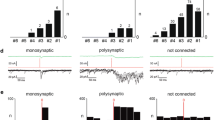Abstract.
The primary motor cortex of cats, monkeys, and humans has distinct rostral and caudal subregions. In the cat, projections from the caudal subregion terminate predominantly in laminae 4–6 and, from the rostral subregion, in laminae 6–8. The purpose of this study was to determine if these distinctive termination patterns are present during early postnatal development, when corticospinal axons are establishing connections with spinal neurons, or if there was postnatal refinement of the distribution of terminations. We used the anterograde tracer biotinylated dextran amine (BDA) to label selectively projections from the two subregions in immature (postnatal days 25, 35 at time of analysis) and mature animals. We compared the distribution of spinal gray matter labeling from caudal and rostral motor cortex. In immature animals, substantial bilateral terminations were present after tracer injection into either subregion. Partial axon reconstructions revealed that individual axons terminated bilaterally. The dorso-ventral laminar distribution of contralateral labeling after caudal motor cortex injections was significantly more extensive for immature than mature animals. In immature animals, most of the labeling was present in laminae 5–7 (dorsal portion), with lesser amounts in laminae 1–4 and 7 (ventral portion), 8, and 9. In mature animals, there were significant reductions in the amount of label in laminae 7–9, resulting in contraction of the labeled territory. The distribution of dorsal horn–ventral horn labeling shifted from 41% and 59% in immature animals to 77% and 23% in maturity. The distribution of contralateral labeling after rostral motor cortex injections also was different in immature and mature animals, but the changes were less extensive than for the caudal motor cortex. In immature animals, the distribution of labeling was similar to that after caudal motor cortex injections in animals of the same age. In mature animals, there was a significant reduction in the amount of labeling in laminae 1–4 and a smaller reduction in 7 (ventral)–9. The overall dorsal horn–ventral horn distribution, however, remained largely unchanged, from 40% and 60% in immature animals to 44% and 56% in maturity. In immature animals after rostral motor cortex injection, corticospinal terminations were present within the lateral motor nuclei. Thus, the distinctive spinal termination patterns of caudal and rostral motor cortex in maturity each reflected postnatal refinement of the distribution of axon terminations. It is plausible that the dorso-ventral refinement of corticospinal terminations relies on activity-dependent competition between caudal and rostral motor cortex, similar to activity-dependent refinement of the laterality of terminations. Our results, however, suggest that the developmental program for achieving corticospinal connectional specificity by the two subregions is different because there was large-scale refinement of the terminations of caudal motor cortex but only local refinement of rostral motor cortex terminations.
Similar content being viewed by others
Author information
Authors and Affiliations
Additional information
Electronic Publication
Rights and permissions
About this article
Cite this article
Li, Q., Martin, J. Postnatal development of differential projections from the caudal and rostral motor cortex subregions. Exp Brain Res 134, 187–198 (2000). https://doi.org/10.1007/s002210000454
Received:
Accepted:
Issue Date:
DOI: https://doi.org/10.1007/s002210000454




